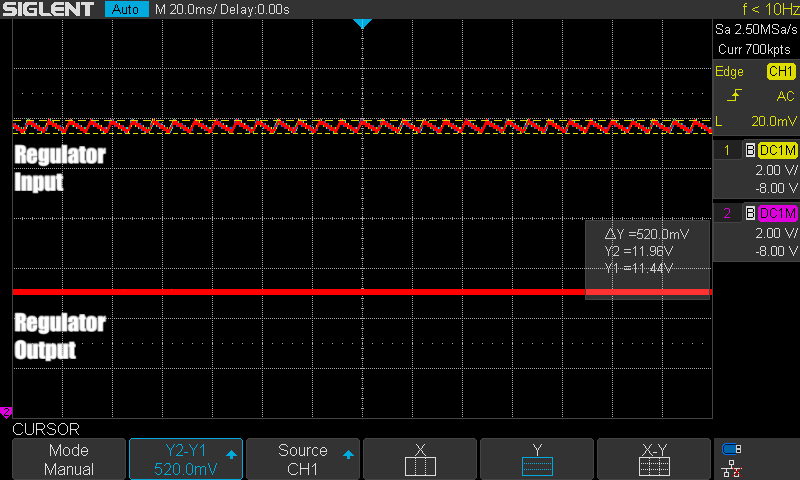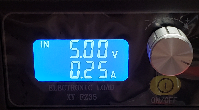§ 2.15 - Heat Sink Considerations
Back to → Main Power Block PageTo heat sink, or not to heat sink, and if heat sinks are required, heat sinks right on the regulator, or large heat sinks and off board regulator mounting... these are the questions that must be answered when you're planning your power supply.
When a 78xx- or 79xx-series regulator is operating, it (approximately) must dissipate power (Pdiss) according to the difference between the average input voltage, and the output regulated voltage, multiplied by the output current in amps. How well it can do that depends on the ambient temperature; the warmer the surrounding air is, the warmer the regulator will get, all other things being equal.
The power dissipation of 78xx- and 79xx-series regulators is internally limited; what that means in practical terms is that if the regulator gets too hot, the output voltage will drop to protect the regulator IC. You don't want that to happen.
"Too hot" in this context means when the silicon inside the regulator package hits about 125° Centigrade, or 257° Farenheit — this is where the regulator's internal circuitry will limit its output voltage to protect the regulator. But really, we never want to get anywhere near this. The outside of the package will be cooler, so you can't use that as a guide, really.
A safe, practical rule of thumb is "if the regulator tab gets too hot to touch with your thumb, it's too hot and needs a heat sink — or a larger heat sink." Also, be careful: these parts can get hot enough to severely burn you if they are not adequately heat sinked for the amount of power they are dissipating.
A good way to determine your actual operating conditions is to employ an infrared temperature measurement tool and a programmable load tool; these instruments can help you to know what temperature the regulator and/or its heat sink is reaching at the maximum current load you expect, and then you can adjust your heat sinking strategy accordingly.
There are some rules of thumb you can use; we'll walk you through how those are arrived at so you'll have a feel for how accurate they are, and how they might apply to your project(s.)
§ 2.15.1 - A Real-world Example
With an average input voltage (Vin) to a 7805 regulator of 11.70 VDC, and as the output regulated voltage (Vout) for this regulator is 5.00 VDC, the difference between the two is is 6.70 volts. If the maximum amount of current (Iout) drawn by the circuitry the regulator is feeding power to is .25 amps (250 ma), then the average power dissipation (Pdiss) as calculated as follows:
(Vin - Vout) x Iout = Pdiss watts
(11.70 - 5.00) x .25 = 1.67 watts
6.70 x .25 = 1.67 watts
Here in the lab, we put this example to the test: A 5.00 volt regulator with a small heat sink (shown below) with an average 11.70 volt input delivering .250 ma of current must dissipate about 1.67 watts; and while it was operating correctly (regulation was within specification), it was far too hot to touch, about 131°F in the lab here, where the ambient temperature when we took these measurements was 73°F. The voltages look fine, as the power supply input isn't that heavily loaded (our lab Power Block is capable of 1 amp input to the regulator) and the regulator isn't quite hot enough to shut down automatically:

11.70 volts average regulator input
5.00 volt regulator output
1.67 watts dissipation
Ambient Temperature: 73°
Regulator heat sink temperature 131°F
(infrared temperature measurement tool) |
(programmable load tool) |
For the example above, the best practice would is to employ off board regulator mounting on a large heat sink; The rule of thumb we derive from this is: If your design will cause more than about 1.5 watts of power dissipation, you should definitely go with external regulator mounting and large heat sinks.
Next, we removed the heat sink entirely, and put a 100 ma load on the regulator; the input voltage averaged 12.05 volts, and so the Pdiss was (12.05 - 5) x .1) = .70 watts; with an ambient temperature of 73°F, the regulator reached 114°F, which is about as hot as we would accept before requiring a heatsink.
Just as a point of interest, with the small heat sink shown above in place, the regulator under test only reached 100°F with that same 100 ma load. You can easily see why an adequate heat sink is a good idea.
§ 2.15.2 - The Practical Take-away
Anywhere up until about 1.5 watts Pdiss, again presuming room temperature, you can get away with a small, on-regulator heatsink.
Above 1.5 watts Pdiss the you must utilize off board regulator mounting, on a substantial heatsink.
In all cases, when the ambient temperature the regulator must operate in will be warmer than room temperature, you'll need more heat sink, sooner, for the same Pdiss
In the end, you will never go wrong in terms of operating temperature by attaching a large heat sink to these regulators. In the case of very low current draws, such as what one of our Mixer Blocks requires (about 10 ma on each of the + and - supplies), you'll find that the regulator's power dissipation without a heat sink is just fine. But again, using a heat sink even in such a circumstance is no problem. Also, if you later decide to use the Power Block for another purpose that requires more output current, it'll be ready to go, so there's that.
Heat-sink paste is strongly recommended between the regulator and the heat sink; and at least in the case of a 79xx-series regulator, an insulator between the metal tab and the heat sink, with heat sink paste on both sides of the insulator, is also a good idea.
For all dual regulator/regulated builds of a Power Block except a dual-positive build, take care to ensure that the heat sinks mounted on the two regulators do not touch each other. This is good practice even if you have used insulators between the regulators and their heat sinks.
Have a question? Ask us via email
, Previous Page . Next Page
o Ordering g Glossary s Sitemap u Updates

